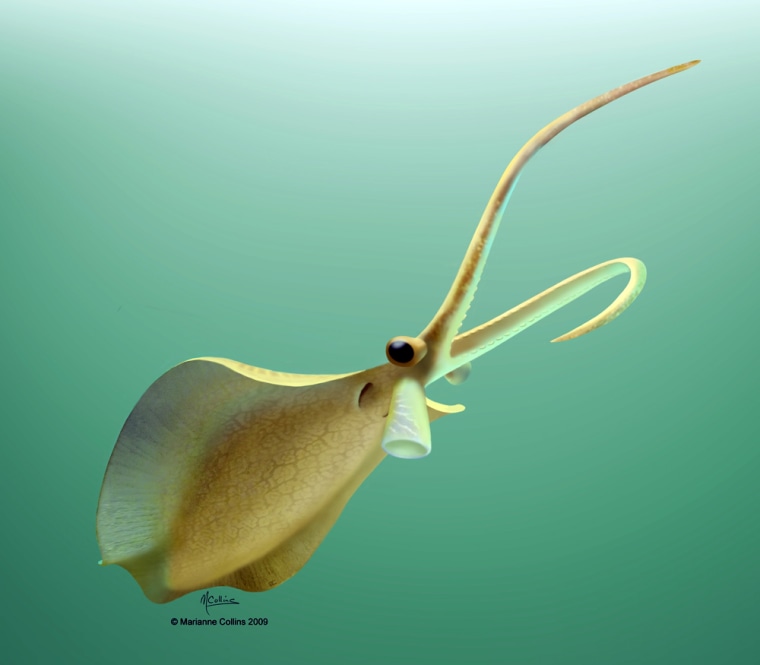A newly identified, 500-million-year-old squid-like creature looked like a cross between a shrimp and a cartoon alien, but it was actually one of the world's oldest and most primitive cephalopods.
The ancient mollusk, Nectocaris pteryx, pushes back the origin of cephalopods, which includes modern squids, octopuses and cuttlefish, by at least 30 million years, making them one of the longest lasting and successful animal groups on the planet.
"The cephalopods are certainly a fascinating and important group of mollusks, and the deep roots of the taxon show that they were an important component of the earliest known complex animal ecosystems," Martin Smith, co-author of the study published in the journal Nature, told Discovery News.
"Modern cephalopods display a quite astonishing intelligence, and I like to think that Nectocaris may have been the smartest critter in the Cambrian sea," added Smith, a paleobiologist at the Royal Ontario Museum's Department of Natural History.
Found in British Columbia
Smith and colleague Jean-Bernard Caron studied at least 91 fossils of the mollusk that were collected from the Burgess Shale, a site located in Yoho National Park near the town of Field, British Columbia.
"Soft tissues of cephalopods tend to decay quickly, so it was difficult to know what primitive cephalopods looked like," said Caron. "The Burgess Shale is well known for its exceptional preservation of soft-bodied animals."
Nectocaris was no exception, as the researchers discovered it did not have a hard shell. For decades, scientists thought the most primitive cephalopod would have a shell, but this latest find "shows us that the first cephalopods actually started swimming without the aid of gas-filled shells," Smith said.
"Shells evolved much later, probably in response to increased levels of competition and predation in the Late Cambrian."
Large, stalked eyes
The prehistoric marine dweller was kite-shaped and flat from top to bottom. It possessed large, stalked eyes and a long pair of grasping tentacles that it likely used to grab and consume prey, similar to today's cuttlefish.
Based on its anatomy, the scientists believe Nectocaris swam using its large lateral fins, but could accelerate thanks to a nozzle-like funnel that squirted out water, propelling the mollusk at a high speed.
It lived in one of the world's earliest rich ecosystems that today seems part familiar, part fantasy.
"The Burgess Shale preserves a wonderful diversity of organisms: some, such as the sponges and shellfish, left descendants which are familiar in today's oceans, whereas others, such as the five-eyed Opabinia with its long feeding nozzle, or the spiny caterpillar-like Hallucigenia, which was originally reconstructed upside-down, are much more bizarre!" Smith said.
2 inches long
He added that most of these early animals were small by today's standards. The largest Nectocaris individuals, for example, only grew to about 2 inches long.
"There would have been a rich array of small, soft-bodied organisms — worms, marine bugs, and various larvae — that Nectocaris might possibly have hunted," Smith said, mentioning that this predator, in turn, was probably hunted by anomalocaridids, "a visually startling organism loosely related to the animal group containing lobsters, millipedes, spiders and trilobites."
In a separate News & Views paper, also published in Nature, paleozoologist Stefan Bengtson of the Swedish Museum of Natural History wondered why Nectocaris "lacks a number of characters that define cephalopods today: a ring of tentacles around the mouth, a beak and a radula (toothed tongue)."
Smith said he and Caron did "identify some possible mouthparts," but that "these were not well enough preserved for us to describe them in detail."
Highlights from the Royal Ontario Museum's extensive Burgess Shale collections will go on permanent display in the museum's future Peter F. Bronfman Gallery of Early Life. They will also appear on the Virtual Museum of Canada Burgess Shale website, to be launched in the spring of 2011.
